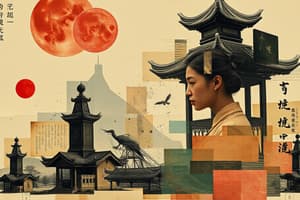Podcast
Questions and Answers
Name two influential literary figures in modern Chinese literature during the Second Sino-Japanese War.
Name two influential literary figures in modern Chinese literature during the Second Sino-Japanese War.
Lu Xun, Mao Dun, Lao She
What was the emphasis of the literary movement of socialist realism in China during the war?
What was the emphasis of the literary movement of socialist realism in China during the war?
Proletarian struggle and collective experiences
Which organizations united writers in their socialist ideologies during the Second Sino-Japanese War?
Which organizations united writers in their socialist ideologies during the Second Sino-Japanese War?
League of Left-Wing Writers, Association of Proletarian Writers
Name two leftist literary journals that provided a platform for writers during the Second Sino-Japanese War.
Name two leftist literary journals that provided a platform for writers during the Second Sino-Japanese War.
What did the novel and short story reflect among Chinese writers during the Second Sino-Japanese War?
What did the novel and short story reflect among Chinese writers during the Second Sino-Japanese War?
谁是参与新诗运动挑战传统形式和探索新思想的诗人?
谁是参与新诗运动挑战传统形式和探索新思想的诗人?
哪些文学社团和组织在第二次抗日战争期间促进作家之间的交流和想法的交流?
哪些文学社团和组织在第二次抗日战争期间促进作家之间的交流和想法的交流?
哪些主要出版社帮助传播广泛的文学作品,使其更广泛地为读者所接触?
哪些主要出版社帮助传播广泛的文学作品,使其更广泛地为读者所接触?
新文学期刊的出现为现代文学的传播提供了一个平台,给作家们提供了一个发展他们技艺的空间。请列举至少两个关键的文学期刊。
新文学期刊的出现为现代文学的传播提供了一个平台,给作家们提供了一个发展他们技艺的空间。请列举至少两个关键的文学期刊。
在第二次抗日战争期间,新诗中出现了哪些新的风格,包括自由诗、政治诗和前卫诗?
在第二次抗日战争期间,新诗中出现了哪些新的风格,包括自由诗、政治诗和前卫诗?
Study Notes
Literature of the Second Decade (1928-1937) during the Second Sino-Japanese War
The Second Sino-Japanese War, which spanned from 1937 to 1945, significantly impacted Chinese literature, particularly during the second decade (1928-1937). Amidst a backdrop of unrest, political upheaval, and military invasion, writers found their voices in literary movements and styles, modern literature prosperity, and leftist literature.
Literary Movements and Styles
In response to the war, Chinese writers developed new genres and styles, seeking to illuminate the realities of the conflict in ways that mirrored their experiences.
- Realism: Writers like Mao Dun and Ba Jin incorporated realistic narratives, aiming to reveal the human condition and the societal effects of war.
- Socialist realism: This movement, influenced by Soviet literature, emphasized proletarian struggle and collective experiences, exemplified in works like Ding Ling's "The Sun Shines Over the Sanggan River" and Xiao Hong's "The Field of Life and Death."
- Existentialism: Lu Xun's "Diary of a Madman" and "The True Story of Ah Q" reflected the existentialist themes of absurdity, isolation, and the struggle for meaning amidst the chaos of war.
Modern Literature Prosperity
During the 1920s and 1930s, Chinese literature flourished, with writers breaking from traditional forms and embracing new styles and genres.
- Resurgence of fiction: The novel and short story became dominant forms of expression among Chinese writers, reflecting the realities of the war and offering a powerful critique of society.
- Increased literary publications: More literary magazines and journals were published, providing a platform for writers to showcase their works and engage in intellectual discourse.
- Influential literary figures: Lu Xun, Mao Dun, and Lao She became significant figures in the literary landscape, contributing to the development of modern Chinese literature.
Leftist Literature
Leftist writers championed socialist ideologies, seeking to redefine the Chinese literary landscape and engage with the realities of war and societal struggle.
- Leftist literary associations: Organizations like the League of Left-Wing Writers and the Association of Proletarian Writers united writers in their socialist ideologies and provided resources and platforms for the dissemination of their works.
- Socialist realism: This literary movement, while briefly popular in China, emphasized proletarian struggle and collective experiences, as demonstrated in the works of Ding Ling and Xiao Hong.
- Leftist literary journals: Journals like "Resistance" and "Liberation" provided a platform for leftist writers to showcase their works and engage in intellectual discourse.
Conclusion
The second decade of the Second Sino-Japanese War served as a critical period for Chinese literature. Writers found their voices in new literary movements and styles, modern literature prosperity, and leftist literature. During this turbulent time, writers sought to illuminate the realities of war, challenge societal norms, and advocate for social justice. While the literary landscape underwent significant changes during the war, the works of this era continue to endure, providing a testament to the resilience of the human spirit in the face of adversity.
Studying That Suits You
Use AI to generate personalized quizzes and flashcards to suit your learning preferences.
Description
Explore the impact of the Second Sino-Japanese War on Chinese literature during the second decade (1928-1937), including literary movements and styles, modern literature prosperity, and leftist literature.




